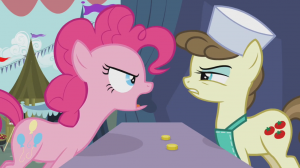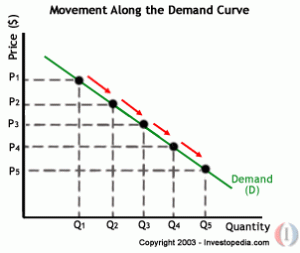How To Do a Kickstarter: Perks
So Kickstarter uses a concept called “Price Discrimination” which allows you to reach different markets simultaneously and increase your profits by including people who won’t pay as much. It’s the same logic as the Playstation “Greatest Hits,” you sell the same game for cheaper after you’ve already sold to all the people who were willing to pay $50 for a $20 game.
But selling in tiers is a little different from just selling a product and later changing your prices. So here’s some advice on how to sell to these markets and maximize profits.
Low Tiers
Pocket change adds up. So do costs. The key to keeping your profits in the lower tiers is to offer something of value while keeping your hard costs (materials, manufacturing, and shipping) down.
Offer something that can be delivered digitally: File downloads, links to hidden behind the scenes Youtube videos, digital drawings, etc. This will keep your hard costs down.
Offer something that costs little and ships for cheap: Autographed photo, drawing, etc.
Thank You Tiers
A Thank You Tier is a tier where the donor gets nothing but a “Thank you.” Most projects have one. I think this is a lack of imagination (see options above) and a leak of potential money.

“No pony wants to buy a THANK YOU! Your appreciation should be an expected part of any transaction! People want to help you, but they don’t want to just waste their money! If you want to penetrate the nickle and dime markets you had better come up with a clever way to actually GIVE A PONY SOMETHING FOR THEIR MONEY AND DO IT FOR FREE!”
As of this writing the Connu campaign is only half-way done and due to the digital nature of their project, they can offer real incentives to their lower tiers without adding to their hard costs. In the $10 and under tiers they’ve earned $553. If this momentum keeps up they will likely fill 10% of their quota with the nickle and dime tiers.
Another campaign I’ve followed was an Indiegogo campaign was for a short film called “Shadow.” This campaign followed so many of my smaller rules and had great business strategy! At the same time there were many oversights that left much to be desired, or even felt insulting to the contributor. For instance they had 2 thank you tiers ($2 and $10), but they will only thank someone on their website if they give $10. How stingy! And what does that say to the $2 contributors? It says that even though they say “thank you” that they don’t appreciate it! It’s no surprise that Shadow only made $62 in the lower tiers, which is less than 1% of their quota.
Middle Tiers
Selling to the middle tiers is usually about value. Is the price reasonable? Is this a value or a good use of my money? Is this rare? Is this special?
You’ll find greater success with the middle tiers if you really show why your project is special and if this is where you’re simply selling your project: Bluray of the movie, copy of the game, CD of the album, etc.
If you have a monopoly on your product and you can generate enough interest in it (why you should invest in your video), then you can safely inflate the price of your wares.
Note: Being too greedy will cost you
Law of Demand states that goods have a price which will yield the greatest profit. If you price something too high, you will sell too little (which hurts profits). If you price something too low, you will sell much more, but you still won’t make much of a profit. The key is to try to find the right value (P3 and Q3 in the chart above). The Law of Demand is sometimes called the “Law of the Bloody Obvious,” probably a British term.
Thus fair pricing will actually increase your profits. You should do a survey of your friends (unless your friends are rich, then ask other people…or actually you should just ask your rich friends for money) to find a good prices. Keep in mind that what people will pay for say “The Brony Documentary” might not be the same as what they’d pay for “indie short film about failed marriage.”
Top Tiers
The top tier donors are usually people who have too much income and want to be apart of something. Money is not particularly a problem with these people. Usually what most Kickstarters do is find a way to either give these donors super rare things, such as evenings with celebrities or autographed rare merchandise or they find some way to include the donor into the creation of the project itself: an NPC (non person character), an extra in the background of your film or comic, etc.
The Shadow campaign had a great strategy for the top tiers: sell to businesses. They offered walk on roles or product placement and advertisements in the film. It’s impossible to tell whether anyone bought this from them or whether they elected to be an extra in the film, so I’ll say they earned 0-10% of their funding this way. Either way it’s a really good idea. If someone won’t spend their own money, they might spend their business’ money.
Tier to Tier Sales
So each tier adds something new to the perks below it for an added cost. Many crowd sourced projects leak money by not making the cost increase equal to what is added. So many of their donors choose a lower tier than they normally would. Now it’s impossible to accurately guess opportunity costs, but I’m going to speculate a little.
The Indiegogo campaign for the unreleased tapes of the Brony Documentary had 227 people donate $10, but only 29 people donate $25. This is a huge drop off from
These were their perks.
$10
-Digital download of film
-Photo album access$25
-Sticker sheet
Essentially you’re paying $15 for a sheet of stickers. These stickers cost more than the actual video file. I wonder how many people donated $10 instead of $25 because they couldn’t justify spending $15 on stickers.
I believe the following would have generated more money for them, simply by adding more value to the added investment.
$10
-Digital download of film$25
-Sticker sheet
-Photo album access
$10 tier just gives the bronies what they want, to see the added footage. $25 gives you the stickers and exclusive access to photos.
That’s it for perks advice! Good luck!
More:
How To Do a Kickstarter: Sharif Acts Like Don Draper on an E-Mail (Public Relations)
How To Do a Kickstarter: Perks
How To Do a Kickstarter: E-Mails
How To Do a Kickstarter (Short Version)
7 Comments
Trackbacks/Pingbacks
- How To Do a Kickstarter: Sharif Acts Like Donald Draper on an E-Mail | Writing Is Magic - [...] How To Do a Kickstarter: Perks How To Do a Kickstarter: E-Mails How To Do a Kickstarter (Short Version)…


Mind-blowing. You define the profit-maximizing price as the fair price. No way I’d ever get away with doing something like that.
Your reasoning is right on the money. The jargon way to put it is to look at the marginal (extra, additional) costs and the marginal benefits of moving up a tier and making sure they aren’t out of whack (scientific term).
I would be lying if I didn’t say that I was worried what you would think of this post. I started it with confidence after we talked about my suggested Duotrope business model which would be way better than their retarded model and then you taught me what price discrimination was.
The more there were sections where I was like “I should explain that” which caused me to wikipedia tunnel. The original version of this blog was like 2,000 words. And it hurt to kill much of it, because I wanted to explain how I think fandoms, especially bronies, provide evidence of how Giffen Goods exist, considering the fact that a guy at Equestria LA bought 2 pony plushies which each cost more that my first car. EACH ONE. There were other plushies…
Oh, also I realize now how claiming that the most profitable margin is the fair price can be/is a fallacy. Being a linguist I assumed stores would always sell at the most optimal point, therefore we would associate that as the “fair price.”
I’m not necessarily disagreeing that the profit-maximizing price is the fair price. “Fair” is pretty loaded, in my experience – that’s all I’m saying.
Woot! I get to get away with things as a layperson! Getting away with things is always preferable to the alternative.
The other “currency” in a KS campaign is social proof. This may distort pricing on the high end and increase the value of low tier contributions beyond their dollar amount.
*Mindblown* Totally didn’t even consider that. This would become an increasing influence as the KS moves along, but negligible in the beginning.
Perhaps a good tactic would be to solicit donations agreements before the campaign begins? That way on the first day of the campaign there will be this social pressure.